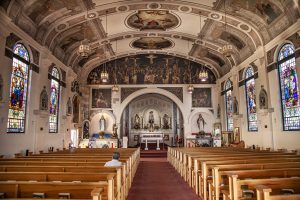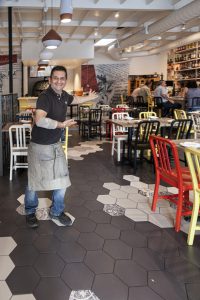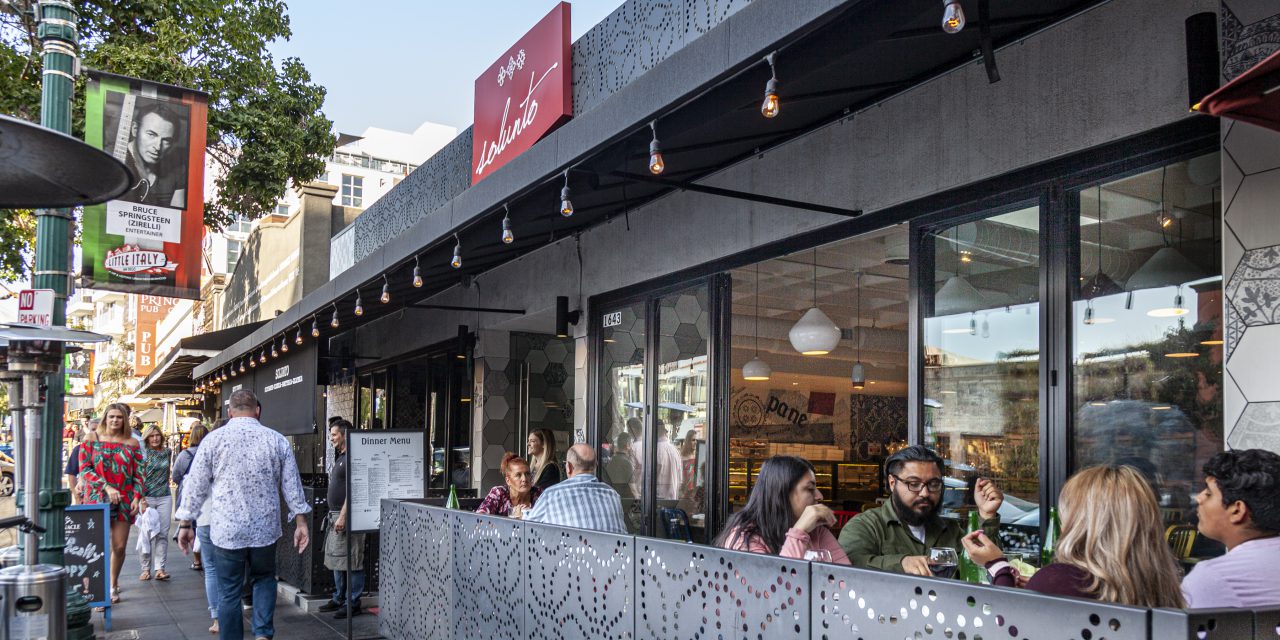Story by Sophia Bauder – Photography by Mohamed Zureik
Imagine Little Italy without the thousands of cars that zoom by on Interstate 5, or the hundreds of restaurants that line the streets next to the modern apartments complexes. Instead, replace it with quaint little homes, mom-and-pop shops run by local families, and the immigration of Italian families that led to the tuna capital of the world. This was Little Italy in the early 1900s.
Little Italy has not always been a hot spot for the locals, tourists, and business industry, but started out as a place where Italian families immigrated to start new. In the 1930s around 6,000 Italian families immigrated from coastal villages in Genoa and Sicily and settled into what is now known as Little Italy, according to articles in The San Diego Union-Tribune. With this, they created a booming fishing industry that lead Little Italy to become the first large tuna cannery.

The Lady of The Rosary Church in Little Italy. (Mohamed Zureik/Impact)
The original families built Our Lady of the Rosary Church where the families would attend Sunday mass. Our Lady of the Rosary was built in 1925 as a way to connect and symbolize a piece of their culture. This historical monument still holds a place in the community and continues to be a place of worship.
Although as time moved on, the tuna industry started to diminish and jobs along with it. In the 1950s the construction of Interstate 5 began and ultimately destroyed half of Little Italy and displaced many of the families that resided here. From this point, Little Italy as we know it started to flourish.
Today Little Italy is a hub of culture that grasps the attention of almost everyone who passes through. Little Italy is now consumed with more authentic Italian restaurants, known as restaurant row, hundreds of new apartment complexes, concert venues, and of course tourists.
“Little Italy is different than Old Town San Diego or Gaslamp it has a whole other vibe and adds diversity, San Diego wouldn’t be the same without it,” said SDSU College Student Zach Duda, who was hanging out in Little Italy’s piazza with his parents recently.
If you venture down India street you will be immersed in the Italian culture that is made up of Buon Appetito, Nonna, BarBusa, Civico 1845, and Solunto Ristorante & Bakery. Some were started 60 years ago, while other restaurants began a few years ago. All are there to bring a taste of Italian cuisine to San Diego. What some people may not be aware of is that a majority of their staff are from Italy and speak fluent Italian.
While these restaurants vary in age, one in particular has been in the community for over half a century, Solunto Ristorante & Bakery. Solunto Ristorante & Bakery has been in business for more than 60 years. The original owner was Mario Cefalu and his family. Mario Cefalu was very involved in the community and known by many. Cefalu even took part in the local soccer team where he got to know the community better. In 2007, Mario Cefalu passed away and his son took over the business from 2007-2011. Today, Soluntos is owned by Antonio Mostelloue and managed by Paolo Tagliani.

Solunto Restaurant & Bakery in Little Italy, with
host Michele Auriemma welcoming guests into his restaurant.
(Mohamed Zureik/Impact)
Under new management in 2011 the restaurant was closed down for remodeling until March 2016 when it was reopened. Solunto Ristorante & Bakery is still rooted in Italian culture, making traditional Neapolitan pizzas, Arancini (Italian rice bowl), and the original recipe for Italian bread that was passed down by Mario Cefalus’ son.
Paolo Tagliani said, “The bread we make today is the same bread that was made 65 years ago.” They bake fresh bread and pastries every day except two days out of the year, Christmas and Thanksgiving.
“Every month we have a customer from Orange County that orders bread from our restaurant, we even have customers from 20-30 years ago that still come in today,” said Tagliani while sitting in his restaurant on a barstool by a granite counter top in front of a large pizza oven. The restaurant smelled like baking pastries and had a large display case that housed Italian pastries and gelato.
“We strive to give good service but above all to give our customers traditional Italian comfort food with flavors from the south of Italy,” he added.
Besides the booming restaurant business, Little Italy has new, up-and-coming hot spots. A new, three-floor concert venue has been added to downtown San Diego right in Little Italy called the Music Box. The Music Box hosts national music artists, local artists, and up-n-coming artists so there’s a little something for everyone. Not only does this venue host live music, but is available for weddings, fundraisers, holiday parties, along with private and corporate events. This may not be a traditional commodity for the Italian neighborhood but shows how it has become more modern and kept up with the times.

Desserts at Little Italy’s Solunto Restaurant & Bakery. (Mohamed Zureik/Impact)
One thing you won’t miss when traveling to Little Italy is the piazza that centers the new food hall and Vici luxury rental apartments. The piazza is covered with bright red chairs that sit under twinkling string lights that looks right out onto Little Italy. You can hear the buzz of conversation from table to table, and even hear whispers of Italian being spoken on the street corners. The piazza is the place to sit, relax, and soak everything in. Not only does the piazza cater to the traditional Little Italy it also introduces the modern aspects. The food hall that sits right in the front offers Asian, Mexican, American and of course Italian to accommodate all locals and tourists.
Little Italy was once a small, intricate community made up of the immigrant families of Italy. Since then, Italian culture has flourished and took its roots in San Diego and continues to be a part of the community. Little Italy has since been modernized but has kept its culture alive. The authentic Italian cuisine, the Piazza that captures the aesthetic and feel of Italy, and the historic monument, Our Lady of the Rosary Church that still stands today are all apart of the old and new Little Italy that has and will continue to be a part of San Diego.






Recent Comments